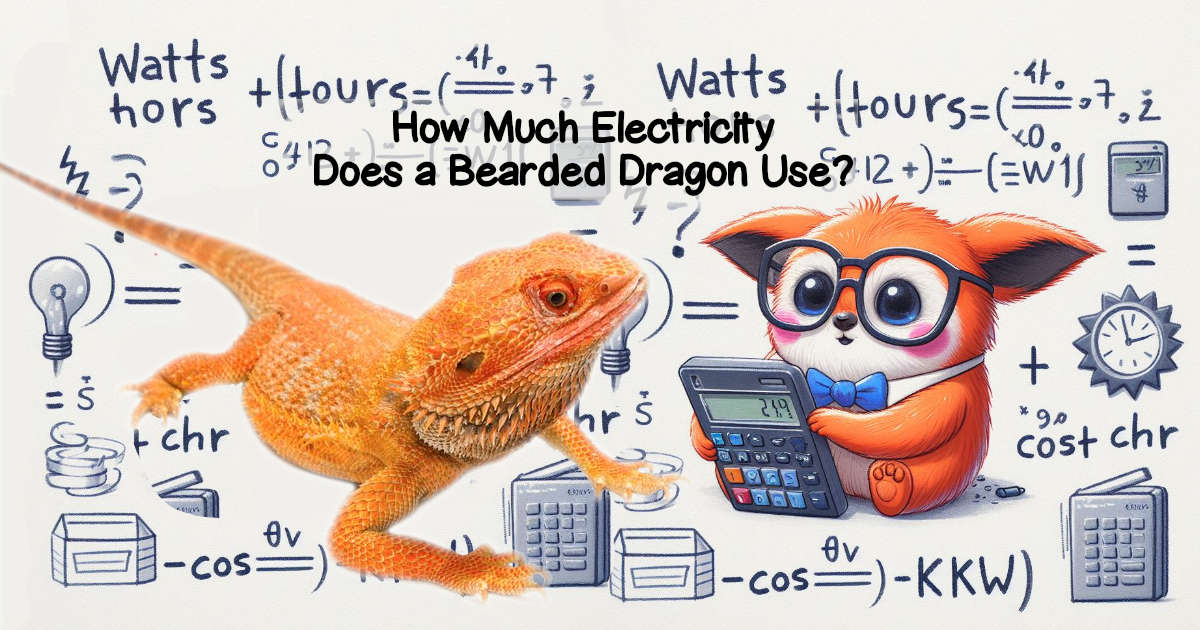The rewarding experience of being a bearded dragon parent can be challenged when unexpected electricity costs arrive. Electricity costs will be one of those added extra expenses on your budget. So, how much does a bearded dragon cost in electricity and how much electricity do bearded dragons use?
The electricity costs associated with maintaining the proper environment for your pet will vary with the climate you live in, power costs and the setup of your bearded dragons housing. To aid in understanding the electricity costs there is a handy calculator below!

Jump To…
Key Takeaways
- The impact of lighting and heating on bearded dragon electricity costs.
- How the climate and your home’s temperature affect energy usage.
- Use our calculator to estimate your bearded dragon’s electricity costs.
- Explore factors like bulb wattage and enclosure size on energy consumption.
- Find tips to reduce electricity costs for your bearded dragon’s care.
The Cost of Comfort: Electricity Usage for Bearded Dragons
Bearded dragons require a controlled environment to thrive, including proper lighting, heating, and occasionally, cooling. These necessities contribute to your electric bill, raising questions “how much does a bearded dragon cost in electricity?” and “how much electricity do they require?”
Maintaining the right environment for your bearded dragon involves several key components, each contributing to the habitat’s overall warmth and light necessary for your pet’s health and well-being. The basic elements include ceramic heat emitters for heat, basking bulbs for warmth and light plus UVB lights for vitamin D3 synthesis. Here’s a breakdown of each component and its associated costs:
8 Factors that Influence How Much Electricity a Bearded Dragon Uses
When considering the costs of electricity associated with keeping a bearded dragon, several factors come into play. These factors influence the immediate environment of your reptile and the broader implications on your electricity bill.
How Much Did Your Electricity Bill Jump?
Imagine this… you come home after a long day at work and settled yourself into your cozy couch with the day’s mail in hand. Among the envelopes, you spot your latest electricity bill. Just last month, you meticulously set up the ideal habitat for your bearded dragon, complete with the perfect heating and lighting to ensure their comfort and health. Everything’s been running smoothly, and you’ve found joy in watching your reptile thrive in its new environment.
With a sense of accomplishment still fresh from creating such a perfect setup, you tear open the electricity bill, curious but not overly concerned. But then, you pause, taken aback by the numbers staring back at you. How much did your electric bill jump since setting up your bearded dragon? How much electricity does it take to run a reptile habitat?
There is a way to know how much electricity your bearded dragon is using. Avoid surprises and work out the electricity costs before hand using the handy electricity costs calculator below. Or do the calculations yourself, instructions below.
Calculator: How Much Does a Bearded Dragon Cost in Electricity per Month or Year?
So just how much does a bearded dragon cost in electricity in a day, a month or even a year? Electricity costs can be an important consideration in the budget for keeping bearded dragons since they need heating and lighting in their habitat.
The Electricity Cost Calculator below can help you work out how much it costs to keep a bearded dragon in electricity over days, weeks, months and years.
How to Work Out How Much a Bearded Dragon Costs in Electricity per Month in 5 Steps
Let’s break down the calculation to understand how much electricity a bearded dragon uses over a period of time, like a month.
- Identify the wattage: First, find out the wattage of each device you’re using in your bearded dragon’s terrarium. For example, if you have a 100-watt Ceramic Heat Emitter (CHE) and an 18-watt UVB strip light, you would add these together:
100 watts (CHE)+18 watts (UVB)=118 watts. - Calculate the daily usage: Next, calculate how much electricity these devices use in a day. If they’re on for 12 hours a day, you would do the math like this:
118 watts×12 hours=1,416 watt-hours per day. - Convert to kilowatt-hours (kWh): Since your electricity bill measures usage in kilowatt-hours, you’ll need to convert the daily usage. There are 1,000 watts in a kilowatt, so:
1,416 watt-hours÷1,000=1.416 kWh per day. - Calculate monthly usage: To figure out how much electricity you’re using in a month, multiply the daily usage by the number of days in the month (or year if you prefer – 365 days). Using 30 days (month) as an example: 1.416 kWh/day×30 days=42.48 kWh per month.
- Totalling how much the electricity costs: Finally, to find out how much it will cost you in electricity to keep your bearded dragon, multiply the total monthly usage by the cost per kWh. If your electricity costs 13 cents per kWh, your calculation would look like this:
42.48 kWh × times $0.13 per kWh = $5.52.
So, in this example, the electricity costs to budget for would be approximately $5.52 per month to provide heat and UV light for your bearded dragon. Remember, these are example figures, and how much your actual electricity costs to keep your reptile could vary based on your specific devices, usage, and local electricity rates.
Tips for Reducing Electricity Costs
- Use timers and thermostat to ensure lights are only on when needed.
- Invest in energy-efficient bulbs like LED for general terrarium lighting.
- Monitor temperature with a thermostat to avoid overuse of heating devices.
- Buy or build an enclosure with some insulation properties, glass tanks do not have good insulation properties and will likely cost more in power to maintain the heat.
Conclusion: Navigating Bearded Dragon Electricity Costs
While the joy of owning a bearded dragon is priceless, understanding and managing the associated costs, especially electricity, is crucial. By following the steps outlined above, you can ensure a happy and healthy life for your pet without any unexpected jumps in your electric bill. Remember, every pet owner’s journey is unique, and being informed and prepared is the key to a rewarding experience.
The journey of caring for a bearded dragon brings immeasurable joy and a unique companionship. However, understanding and managing the bearded dragon electricity costs that accompany creating a suitable habitat for your pet can make life more financially comfortable for you.
Each bearded dragon pet owner’s experience is distinct, shaped by the specific needs of their pet and the conditions of their home. Being well-informed and proactive about the various factors affecting electricity costs is important. A proactive approach allows you to enjoy the rewarding experience of pet ownership fully, with peace of mind knowing you’re providing the best care possible in a cost-effective manner.
FAQs
How much does a bearded dragon cost in electricity?
The electricity cost for a bearded dragon can vary dependent on conditions. The cost of electricity could be $10 per month, depending on the wattage of the bulbs, how long they are on for, any electricity saving devices connected (such as thermostat) and the local cost per kWh.
How much electricity does a bearded dragon use?
A bearded dragon could use around 1.5 kWh per day (more or less depending on the conditions), considering the combined usage of heating, basking, and UVB lights, which translates to approximately 45 kWh per month.
How much electricity do bearded dragons require?
How much elelctricity bearded dragons require is very dependent on the conditions. An estimate could be around 1.5 kWh of electricity daily to maintain the proper heat and lighting in their terrarium.
References
Synergy. (n.d.). Electricity bill calculator. Synergy.





